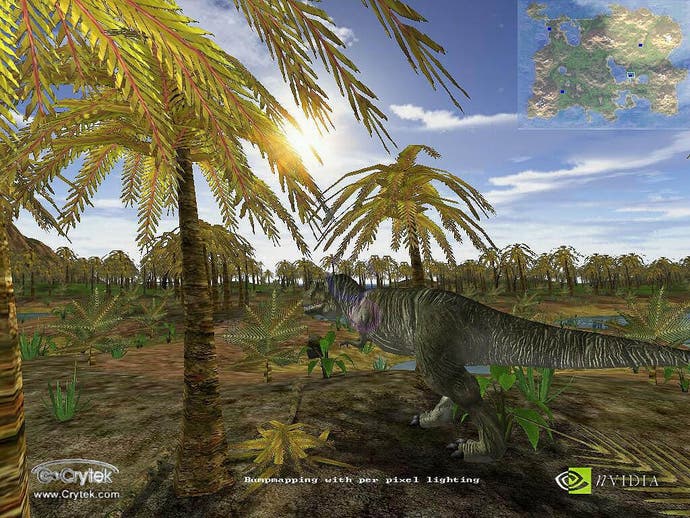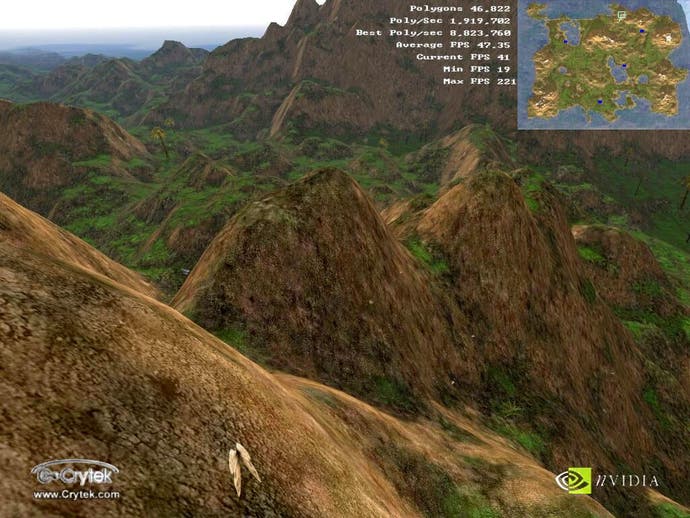Alan Tiquet of NVIDIA
We talk to NVIDIA's European marketing director to find out more about the company's plans for global domination...
Over the last year NVIDIA has built up a strong position in the 3D graphics market, replacing 3dfx at the top of the pile when it comes to innovative new features and raw performance with the release of the GeForce 256 in September 1999, and dominating the top end of the graphics card industry with virtually no competition for almost a year, until the recent arrival of 3dfx's Voodoo 5 5500 and ATI's Radeon 256. During the recent computer games trade show ECTS 2000 in London, NVIDIA were again showing an impressive new graphics card, this time the GeForce 2 Ultra, which boasts an improved manufacturing process and faster memory to make the most of the old GeForce design. We spoke to the company's European marketing director, Alan Tiquet, to find out more about how NVIDIA got to the top, and how they plan to stay there...

Ultra
The GeForce 2 Ultra is something of a stop-gap measure, created almost by accident, and now filling in for their true next generation card the NV20, which has been delayed until Spring 2001 awaiting the arrival of Microsoft's new DirectX 8.0 API. The main difference between the GeForce 2 Ultra and the recent GeForce 2 GTS is in the way that it is manufactured, as Alan explained to us. "We had to work at the chip level to do some experiments on the process [used to make the graphics cards], and what we did with this product was to work at the transistor size level. To get faster speed and lower power consumption, we have to reduce the size of the transistors. So we did this exercise with the GeForce architecture on a new process - still 0.18 micron, but 0.18 with very small transistors." "This process worked very very well, so we said "Ok, let's take it out to the market". It just fit very well into our strategy to double the performance [of our cards] every six months. We got up to one billion pixels per second, which is twice the GeForce 2 GTS, so we thought, "Let's do it". We were not expecting this process to work - we were working on it for a future product, but since it worked very well..." "If you remember what we did with the TNT, the TNT was a new architecture, [while the] TNT2 was a new process. We did the same thing with the GeForce 256, we went to the GeForce 2 GTS. Not only did we change the process, but we also added some new features. But this time we just moved to a new process again. So you can get very very high speeds, but the construction is still the same."

Memory
Of course, increasing the efficiency and performance of the core chip is not enough to increase the performance of the cards which are based on it. As any good hardware fanatic knows, the GeForce cards are often held back by memory bandwidth limitations rather than raw power. "The issue here was to get the right memory with it", Alan told us. "From product to product, from architecture to architecture, you always have to solve this memory bandwidth problem." In the case of the GeForce 2 Ultra, the answer was simply to go to a faster form of DDR memory, this time 4ns memory running at an effective speed of 460Mhz, almost 40% faster than the memory on the GeForce 2 GTS. But using this newer, more exotic memory comes at a cost, literally - GeForce 2 Ultra cards are expected to retail for around $500. "It's expensive at every level. This product is the beginning of a new process and technology. We have to find the 4ns memory and pay a fair price for it. And then when it comes to the quality of the board, the design of the board, the manufacturing, it gets expensive." Obviously companies can't just go on using faster and faster memory forever, and "probably the next product generation is going to work in different ways to improve the bandwidth, using the available memory technologies. We know that there are limits, and we are going to go to those limits, and then we have to find different ways. This is what we are dealing with today." "When we get up to these 4ns speeds for memory access, you have to make sure that termination lines and so on go all the way down, and we spend a lot of time just working on the reference design. And now most manufacturers, when they use the chip, their ability to change things is getting narrower and narrower with the tolerances."

Segmented
The GeForce 2 Ultra's hefty price tag means that it will only really appeal to the hardcore market, but when we asked Alan about how much of a market there really was for a $500 graphics card, he explained that "it's all about market segmentation". "The market is, let's say, in three parts - high performance, mainstream, and entry. And then there is what we call the Level 0, which belongs to Intel - the 810 and 815 [motherboards with integrated graphics]. Clearly we are very good in the top end. In the last six months we have been owning this segment with GeForce, GeForce 2 GTS. The GeForce 2 Ultra is going to be the cream of the cream, for the hardcore gamers who are willing to pay $600 for such a product. So far we are doing pretty well in this area, and I think we own about 70 to 80% of this high end market." "Our main problem is the mainstream and entry level - we are not there, yet. So what we did was design a product for the mainstream, the MX. We say at NVIDIA that this is our bread and butter for the next two years, this is what is going to make our company successful, this is what is going to grow the 3D market. It has to be everywhere. The performance is right, we have all the features which are going to be needed in the next two years - T&L, per pixel shading, everything you need." "And not only on the desktop, we have to be on mobile computers as well. We are working with notebook manufacturers, saying "Hey guys, we have a product which has been designed for you, with power saving features, the right performance, cost". So we are working with those guys to get designs." NVIDIA aren't limiting their ambitions to just the PC either, they are also planning to move into the Mac market, where ATI and 3dfx are currently the dominant forces. "We said to the Mac market, "If you want to use this product, it is ready for you". It's up to Apple to decide, but we are ready."

MX
Whilst the GeForce 2 Ultra is expected to cost about $500, the GeForce 2 MX is available for under $150, making it ideally placed to take on the lower end of the 3D graphics market. As Alan told us, "what we want to do is grow the 3D market, and as soon as the 3D market grows we are going to benefit. Keeping the same market share, if the market grows we get more business." And the GeForce 2 MX is the spearhead of NVIDIA's efforts to penetrate the entry level and mainstream markets, forming the basis for a whole new line of products. "You will see the GeForce 2 MX as a product being worked and reworked as we need, for as many applications and market segments as possible. This is going to be our core product for the next two years, we want it everywhere." As Alan pointed out, the potential market for a low cost but high performance graphics card is massive. "The TNT2 has been here for over 18 months now, and we are shipping 70% of our volume still TNT2. It's huge. And this is what is going to replace it - the objective is to get the MX to move in and swallow all the TNT2 market. And then we have the other product, really entry level, the GeForce 2 MX PCI. It's available, it's up to the board manufacturers to get them ready, and they are going to be there I think by October. Because there are so many 810 PCs on the market, and all those people are just crying "my graphics suck"." NVIDIA have recently started to challenge even in this "level zero" market of integrated graphics solutions, with the Aladdin TNT2 chipset. "When you are bringing something in every six months, you have a pyramid", Alan explained. "When you put something on top, everything goes down one step. If you look at what we have done in the past with the TNT2, last year the TNT2 was the best product on the market place, now the cheapest good 3D graphics you can get is with the Aladdin TNT2 chipset. Within 18 months, the level zero have access to the best technology in the market place." "This is the value of adding things on the pile, because everything else goes down, and you are going to see that the GeForce architecture in 18 months is going to be down at the level zero. At the end of the day you have the early adopters, who get the best when it is available. Then you have people who are more conservative, maybe have less money, and now they can buy the GeForce 2 MX at a very affordable price. And wait another six months or nine months, and then people who know nothing can get it."

The Future
While the GeForce 2 MX is going to be NVIDIA's answer for the mid and low range market over the next couple of years, they are also working on new products to put on the top of the pile. When we asked Alan about these, he joked "I can talk about them, but I cannot say much". So instead he gave us a fascinating insight into how chip design works at NVIDIA... "We have three design teams. Each of those design teams has a slot allocated, one every six months. You have Fall 2000, you have Spring 2001, and you have Fall 2001. Go! And so you have to reach this window, and if you miss it .. this guy is going to take over, and you are going to lose your job!" "The company works that way. We have objectives within the company, every six months we bring something out. What it means, when they design a product, the first .. the only objective is to get it in on time. You cannot say, "Oh we are going to be three months, four months late" - it's not going to work. If they cannot reach the window with all the specifications they have, they cut the specification to make sure it meets the window." "That's why we cannot really talk about the specification [of a future chip] until the guys say "Ok, the design is frozen and we go for it". Six weeks before the product is released, we say "Ok, it's done, it's ready", and this is when we come to you. That's why talking about specifications, maybe the key features which we are aiming for today are not going to be in it, and it would be very frustrating for everybody, including our customers and your readers."
"From a pure business point of view, announcing a new product and then not delivering it freezes the market. People do not buy this product because they are waiting for the next one. If you are interested in the GeForce 2 GTS, but it's very expensive, and we say there's going to be a new one tomorrow, what would you do? And if you are late, they are going to wait, wait and wait, and maybe buy somebody else's product. That is why we announce the product and we get it done."

Board
NVIDIA's main product is chips, and when we asked Alan if the company might diversify into making the boards which the chips go on as well and selling them directly, he replied that "it doesn't make sense". "In this industry you have to understand where your area of expertise is. We are very good so far .. we have been very good, let's say, designing graphics chips, and designing the drivers that you get with the whole family of products. This is our area of expertise. For the rest, we work with the best in the industry to get things we cannot do by ourself." "On the board manufacturing level, there are plenty of people who are expert at manufacturing boards. Any OEM can get boards with NVIDIA technology, and they have a choice of product features at the board level, choice of quality, depending on what market you are looking for, what kind of specification. And last but not least, in terms of cost, you can deal with several guys and get the best price for a given specification." "At the end of the day, what do you want? We cannot do that by ourself. We cannot have a choice of sixteen boards doing it by ourselves. Today we just ship as many products as we want to sixteen different manufacturers, and you have sixteen choices of supplier. The experience we have in the past two years is that chip manufacturers moving into the board business have not really been successful. Because you are just losing focus." Looking at the experience of 3dfx (who took over STB) and S3 (who merged with Diamond), you can see his point. While companies like 3dfx, ATI and Matrox all make their own boards exclusively, NVIDIA are one of the few companies that still supplies graphics chips to a wide range of manufacturers.
Detonation
And so the interview was over. But before we left, there was one final quick question which we had to ask. How exactly did NVIDIA manage to provide a 25% performance boost for their graphics cards with the new Detonator 3 drivers? "Very easy", Alan told us. "We started with Detonator, and when we design a chip we design compatibility with the driver - it's like the instruction set, x86, it just has to be compatible, this is the first thing. Detonator is about two years old, it has grown through this time with additions, new products, new features." "What we decided to do was take the driver from zero again with Detonator 3, and rebuild it from scratch, with no outdated calls and so on. So we redo it, and go for another two or three years until it is getting too big and too heavy to handle, and then we do another one." "The key thing for us is compatibility. This Detonator 3 runs on a TNT, and it's going to run on our future products for the next two years. The key thing is we have re-worked it from scratch to get the performance boost." So now you know...
-
Noddy's Guide To Graphics Card Jargon

